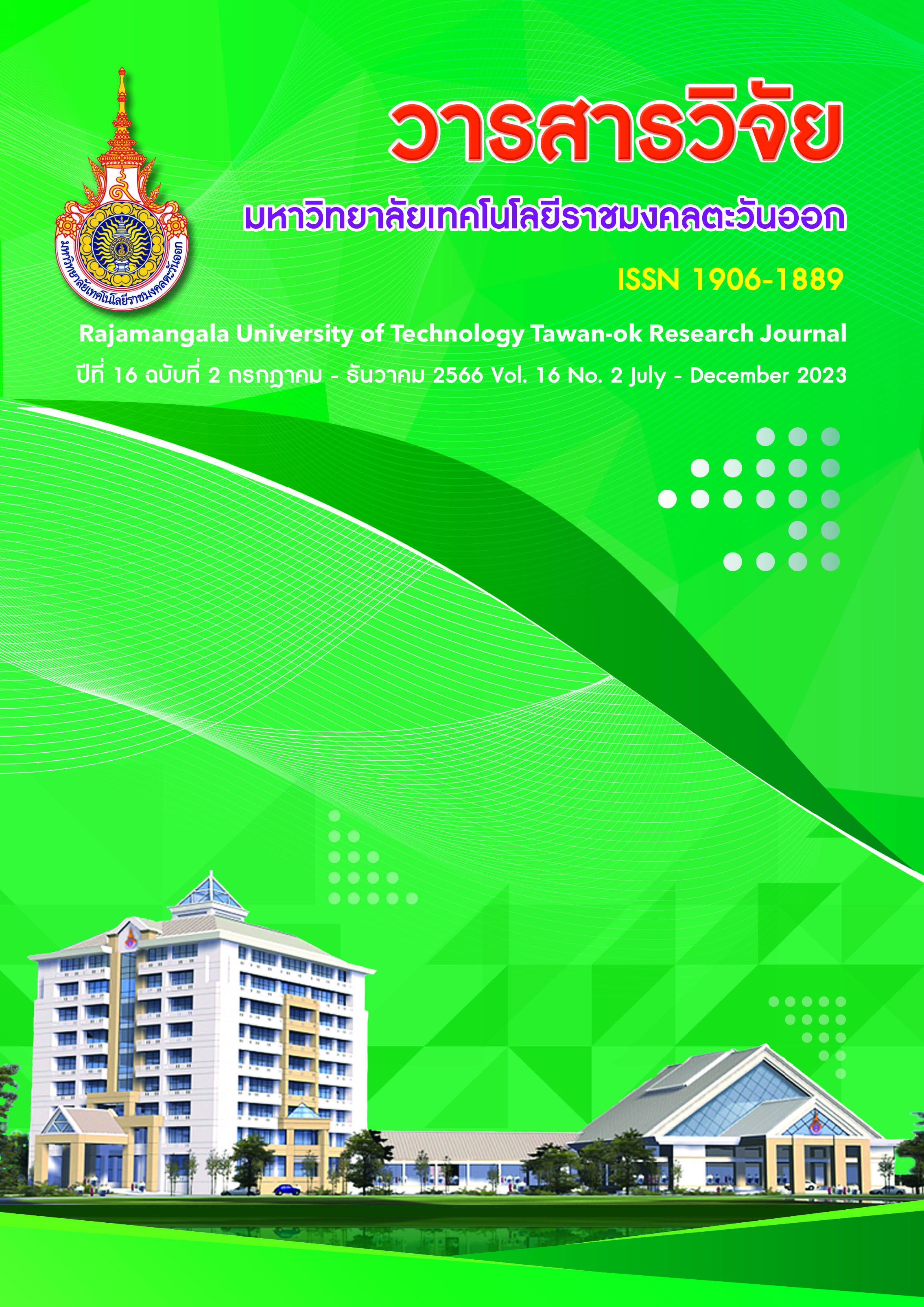Feasibility Study on The Use of Reduced Graphene Oxide-Iron Oxide Composite for Removal of Hexavalent Chromium in Wastewater
Main Article Content
Abstract
This research has studied the ability of the reducing graphene oxide-iron oxide composite (Fe2O3-x%RGO) to get rid of hexavalent chromium in wastewater by preparing a composite sample between reducing graphene oxide-iron oxide by the solvothermal method Then take the sample substance that has been analyzed for morphology with SEM. The structure can be analyzed with XRD. The optical properties and the photocatalytic efficiency studied with UV-vis machines. Examining the magnetic properties using VSM. The SEM analysis results show that iron oxide particles spread on the surface of graphene oxide and insert between layers of graphene oxide. In the section XRD found that the reducing graphene oxide-iron oxide composite substances show the structure of the hematite iron oxide (Fe2O3) and the effect of VSM showing the ferro-magnetic properties. The effect of UV-vis can bring the absorbance of the sample substance can be analyzed that the reducing graphene oxide-iron oxide composite substances has an energy gap between 2.50 – 2.80 electron volts. In addition, the analysis of the photocatalytic efficiency of the reducing graphene oxide-iron oxide composite substances in the removal of hexavalent chromium in wastewater found that the composite substance Fe2O3-20%RGO is best able to get rid of hexavalent chromium solution. And the decrease in hexavalent chromium concentration (Cr (VI)) makes it known the efficiency of the photocatalytic of the sample.
Article Details

This work is licensed under a Creative Commons Attribution-NonCommercial-NoDerivatives 4.0 International License.
References
Abasali karaj abad, Z., Nemati, A., Khachatourian, A.M., & Golmohammad, M. (2020). Synthesis and characterization of rGO/Fe2O3 nanocomposite as an efficient supercapacitor electrode material. Journal of Materials Science: Materials in Electronics, 31: 14998-15005.
Ahmad, W.R.W., Mamat, M.H., Zoolfakar, A.S., Khusaimi, Z., & Rusop, M. (2016). A Review on Hematite α-Fe2O3 Focusing on Nanostructures, Synthesis Methods, and Applications. The 13th IEEE Student conference on Research and Development (SCOReD 2016). The IEEE Malaysia Section, and IEEE International Islamic University (IIUM) Student Branch. Kuala Lumpur, Malaysia.
Alice bush. (2018). Iron oxide nanoparticles, characteristics, and applications. Retrieved 5 June 2023, from sigma-aldrich.com.
BBC Thai. (2017). Klity: An old story that made a new chapter in the history of community environmental cases. Retrieved 5 June 2023, from https://www.bbc.com/thai/thailand-41225292. (in Thai)
Board of Dartmouth College. (2004). Iron oxide stoichiometry. Retrieved 5 June 2023, from dartmouth. edu. (in Thai)
Chairot, M. & Panya, P. (2019). Adsorption of hexavalent chromium using Eichhornia crassipes. Proceeding of The 6th National conference KPRU Kamphaeng Phet Rajabhat University Proceeding (pp. 577-586). Kamphaeng Phet: Kamphaeng Phet Rajabhat University. 20 December 2019.
Changsuwan, A. (2019). Hexavalent Chromium in Food. Depatment of Science Service Ministry of Science and Technology, 68(209), 26-28.
Chen, K.-L., Yeh, Y.-W., Chen, J.-M., Hong, Y.-J., Huang, T.-L., Deng, Z.Y., Wu, C.-H., Liao, S.-H. & Wang, L.-M. (2016). Influence of magnetoplasmonic γ-Fe2O3/Au core/shell nanoparticles on low-field nuclear magnetic resonance. Scientific Reports 6: 35477.
Danwittayakul, S. & Thanaboonsombat, A. (2013). Do you already know “hexavalent chromium”, a dangerous substance near you. Materials Technology, 68: 12-18: January - March 2013.
Khamboonrueang D., Srirattanapibul S., Tang, I-M., & Thongmee, S. (2018). TiO2∙rGO nanocomposite as a photo catalyst for the reduction of Cr6+. Materials Research Bulletin, 107: 236-241.
Liang, Y.C., & Hsu, Y.W. (2021). Enhanced Sensing Ability of Brush-Like Fe2O3-ZnO Nanostructures Towards NO2 Gas via Manipulating Material Synergistic Effect. International Journal of Molecular Sciences: 1-12.
Modafferi, V., Santangelo, S., Fiore, M., Fazio, E., Triolo, C., Patane, S., Ruffo, R., & Musolino, M.G. (2019). Transition Metal Oxides on Reduced Graphene Oxide Nanocomposites: Evaluation of Physicochemical Properties. Journal of Nanomaterials Vol 2019: 1-9.
Narawong, W. & Panya, P. (2017). Preparation of Cellulose from Water Hyacinth Leave to Adsorb Cr (VI) Ion. Proceeding of The 4th National conference KPRU Kamphaeng Phet Rajabhat University (pp. 957-966). Kamphaeng Phet: Kamphaeng Phet Rajabhat University. 22 December 2017.
Perumal, S. & N. T. Selvi. (2013). Spectral Evidence for the One-Step Three - Electron Oxidation of Phenyl sulfonyl acetic Acid and Oxalic Acid by Cr (VI). American Journal of Analytical Chemistry, 4: 20-29.
Rahman, M.M., Khan, S.B., Jamal, A., Faisal, M., & Aisiri, A.M. (2011). Iron Oxide Nanoparticles. Nanomaterials. 43-66. Retrieved 5 June 2023, from https://www.intechopen.com/books/861.
Sergey, D., S. Gilje, K. Wang, V.C. Tung, K. Cha, A. S. Hall, J. Farrar, R. Varshneya, Y. Yang & R.B. Kaner. (2010). A One-Step, Solvothermal Reduction Method for Producing Reduced Graphene Oxide Dispersions in Organic Solvents. ACS Nano, 4(7): 3845-3852.
Uma, K., Chong, S., Mohan, S.C., Jothi Venkatachalam, K., Yang, T.C.- K., & Lin, J.-H. (2020). Multifunctional RGO-supported α-Fe2O3 nanocomposites for high-performance pseudo capacitors and visible light–driven photocatalytic applications. Ionics (2020) 26: 3491-3500.
Wang, J.-C., Ren, J., Yao, H.-C., Zhang, L., Wang, J.-S., Zang, S.-Q., Han, L.-F., & Li, Z.-J. (2016). Synergistic photocatalysis of Cr (VI) reduction and 4-Chlorophenol degradation over hydroxylated α-Fe2O3 under visible light irradiation. Journal of Hazardous Materials 311: 11-19.


